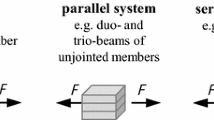Abstract
Structural design is today concerned with single component performance where each limit state is related to a single mode of failure of a single component. Further, in limit state codes the strength variables are related to a deterministic value (usually the 5-percentile). However, in a structure with a number of elements, two different effects (called system effects) can be found:
-
The probabilistic system effect that is based on the reduced probability that weak sections coincide with the most stressed sections.
-
Structural load-sharing that is the ability to redistribute load between members.
In this paper, Monte Carlo simulations of a timber W-truss with punched metal plate fasteners (nail plates) are performed. Structural timber displays a significant variability in strength and stiffness both within and between members and is described by a statistic model calibrated against data from Norway spruce (Picea abies). Most studies found in the literature are based on linear-elastic theory and the variability within members is neglected mainly because of lack of data. The FE calculations are performed by TrussLab – a toolbox for MATLAB developed at Aalborg University. TrussLab considers contact between timber members and non-linear behaviour of the joints. The timber members are given linear properties.
The system effect is based on reliability analyses. The system effect found depends on the coefficient of variation, the distribution of the random load variable and the reliability level. Depending on the assumptions, the system effect was found to be in the range 8–25%.
Similar content being viewed by others
References
Gupta R, Gebremedhin KG (1992) Resistance distributions of a metal-plate-connected wood truss. Forest Products J. 42(7–8):11–16.
Sørensen JD, Damkilde L (2003) Load bearing capacity of roof trusses. Paper no. 226. ISSN 1395–7953 R0309 Aalborg University, Denmark.
Hansson M, Thelandersson S (2002) Assessment of probabilistic system effects on the reliability of timber trusses. Mater. and Struct 35: 573–578.
Eurocode 5 (2002) prEN 1995-1-1, Design of timber structures–part 1.1. CEN Final draft 2002-10-09. Bruxelles, Belgium.
Riberholt H (1990) Proposal for eurocode 5. Text on timber trussed rafters. CIB-W18 23-14-2 Lisbon, Portugal.
Ellegaard P (2002) Analysis of timber joints with punched metal plate fasteners, paper No 11, PhD thesis. Aalborg University, Denmark.
Isaksson T (1999) Modelling the variability of bending strength in structural timber. Report TVBK-1015, Dept. of Structural Engineering, Lund University, Sweden.
Sørensen JD, Hoffmeyer P (2001) Statistical analysis of data for timber strengths. Report, Aalborg University, Denmark.
prEN 338 (2002) Structural timber – strength classes. Final draft October 2002. European committee for standardization, Brussels.
COMREL & SYSREL (1997–1998): User Manual, RCP Consult, http://www.strurel.de.
Author information
Authors and Affiliations
Corresponding author
Rights and permissions
About this article
Cite this article
Hansson, M., Ellegaard, P. System reliability of timber trusses based on non-linear structural modelling. Mater Struct 39, 593–600 (2006). https://doi.org/10.1617/s11527-006-9098-8
Received:
Accepted:
Published:
Issue Date:
DOI: https://doi.org/10.1617/s11527-006-9098-8




